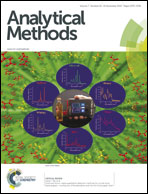A novel, fast and cost effective graphene-modified graphite pencil electrode for trace quantification of l-tyrosine
Abstract
A simple and novel method for detecting L-tyrosine in urine was introduced using a graphene-modified graphite pencil electrode (GR-modified GPE). Graphene oxide (GO) was directly reduced using cyclic voltammetry (CV) on the surface of the GPE. The synthesized GO was characterized by FTIR and Raman spectroscopy. The morphology of the electrode surface was characterized by field emission-scanning electron microscopy (FE-SEM) and the electrochemical properties were characterized by CV, electrochemical impedance spectroscopy (EIS), and square wave voltammetry (SWV). The graphene layer on the GPE dramatically enhanced the electroactive surface area and electrochemical oxidation of L-tyrosine. A satisfactory linear response was obtained in the square wave voltammogram from 0.8 μM to 60 μM, with a regression constant (R2) of 0.9995. The modified electrode yielded a low L-tyrosine limit of detection of 0.07 μM. The present modification process is completed within 5 min compared to other reported time-consuming methods. The modified electrode surface was free from interfering species and successfully applied to the determination of L-tyrosine in human urine. The low cost and easy to modify electrode displayed excellent sensitivity, selectivity, and reproducibility, a low limit of detection and a wide linear response range.


 Please wait while we load your content...
Please wait while we load your content...